Someone once said my life was like a comic book….
I had survived the late night muggers in snow thick Central Park (with the help of Spider-Man), I’d flown over the Oregon Trail to Portland and to the love of my life, KK. I’d been duped. She wasn’t waiting for me. She was with another guy and his sulky kid. KK’s three-year old, Arrow, was more friendly. He remembered me from the previous year in London, and he liked comics. I was shaken up by the unexpected reception, but I was alive. It was Xmas 1972, and my timing was perfect for the annual northwest comic mart.
After the mart, it seemed the plan was to stay with KK and her boyfriend at their farmhouse in faraway Idaho. I had to buy enough comics to see me through the situation I was entering – two men and one woman in a remote part of Idaho – it sounded like a recipe for disaster.
It turned out to be a nightmare journey by road over almost two days and nights, through blizzard and storm, high mountains and sheer precipices. The iced-over valley was in the middle of nowhere. New York in winter was bad enough, but a remote valley in a desolate Idaho backwater was far worse. Nonetheless, I had done well at the Portland mart – particularly with a few issues of Golden Legacy, unique educational comics published in the late 60s and early 70s that focused on important figures from black history. They were groundbreaking for their time.
Since I was visiting the ‘Wild West’ (sort of), I was delighted to find Golden Legacy vol.12, which told the true story about black cowboys. I’ve spoken about black cowboys in a previous post, and the portrayal of the American west in popular culture. It was the making of a myth – quite literally a whitewash. The true story was that a quarter of all cowboys were black. Of course in the movies, comics, and pulps, the black rodeo stars who had dominated the scene at the time all got painted white. I always thought that maybe there was significance in the fact that Stalin loved westerns.
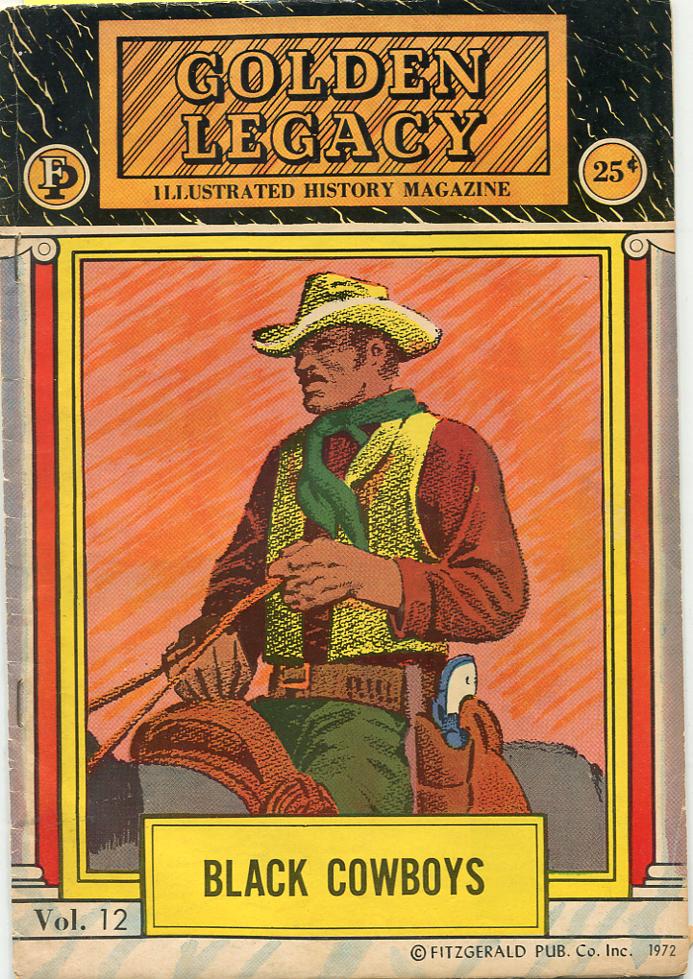
Meanwhile back in Idaho… We were chugging along in a decrepit pickup – two kids and three adults sharing blankets, squashed inside a tiny cab with little or no heating. The pickup groaned and spluttered as we slid down an invisible track into the desolate Idaho valley. Way back, we’d coasted through the last point of civilization – Coeur d’Alene – a one-horse small town sleeping under a blanket of snow.
While the pickup waited, juddering and wheezing – too risky to switch off the engine – KK sent me to grab their keys from their only neighbour. Standing in the open doorway was a tall, rangy, wild-haired black fellow. He gave me a serious once over and a set of keys. KK told me that he was a Black Panther on the run from Chicago. What for? No answer. But I was sure I’d seen him before – in a comic book. Little did I know that before long I would be putting my life in his hands…
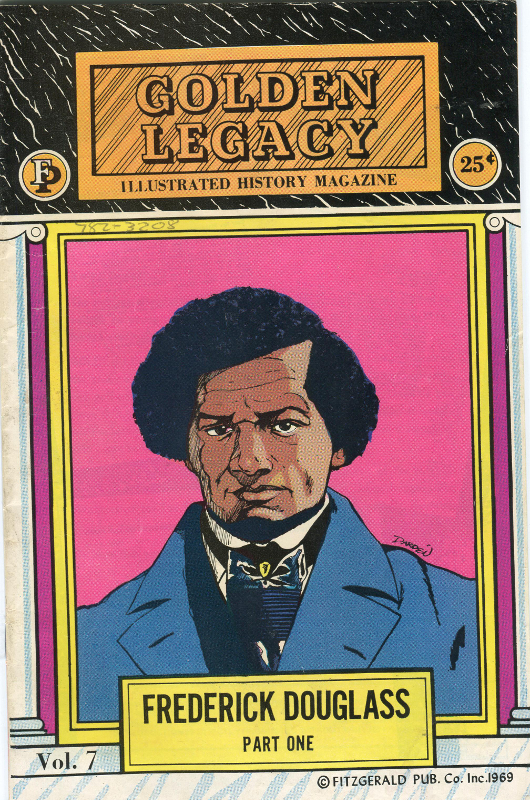
The neighbour reminded me of Frederick Douglas – the escaped slave, abolitionist and social reformer who became Lincoln’s social conscience. With help from Uncle Tom’s Cabin, he inveigled Lincoln into the Civil War. His story was also told in the Golden Legacy comics. In the Frederick Douglas issue though, I found the artwork difficult. It didn’t have the prevailing grid layout of the other titles and veered toward the illustrative with its own sequential grammar and sparse backgrounds, often left blank. But its historical veracity remains strong.
Back in the pickup, my nerves were frazzled. The boyfriend seemed loopy and fuelled by vodka. He made money selling crystals and charms with mystical powers. He had bloodshot eyes – a classic pulp villain! Worse, he was disdainful about comics – he was a ‘grown up’ he said. I was thankful that in contrast, KK and Arrow heartily applauded my addiction.
I desperately needed an infusion, but I couldn’t get to my stash in the back of the pickup. All I could do was select frames from my mind’s eye. Captain Marvel Adventures #113 seemed appropriate – witty, with exquisite, clear-line penmanship. Artist CC Beck’s line seemed to breathe on the page. It was a metaphor for McCarthyism and apartheid wrapped up in one story. Somehow it sneaked in under the radar. It may have been the most strident subversion of the era, or maybe interpreted simply as pure kids stuff. The advantage of comics being regarded as innocuous meant freedom. If anyone took comics seriously, it had to be a joke – no matter what they were getting at. The door was open!
That Captain Marvel comic had great significance to me. When I was twelve, I gave a talk on comics at school in Cape Town to some other white boys from the Civic Society. I don’t know if anyone fathomed what I was really saying. As a matter of fact the subversive #113 got me accredited to give more talks, eventually unsupervised. A couple of years later, when I was fourteen, I arranged another talk – something ‘innocuous’ I thought. At the last moment I announced it; the talk was about race and apartheid.
About forty white boys listened attentively. I said that the truth of township enormity was as secret as Hitler’s concentration camps were. They went berserk. They called me a liar and beat me up. The passing deputy head heard the furore, saved me, then promptly took me off for a caning. That’s what one issue of Captain Marvel led to. Decades later, comic book cognoscenti Paul Gravett presented me with a copy of #113. It was exactly as I had remembered.
Only a few years after that first (and last) caning, Captain Marvel was in deep trouble. Captain Marvel was one of the most successful superheroes in the 1940s, far outselling Superman at one point. Though younger, wasn’t he better than Superman? Sadly, in the end, the Captain succumbed not to some super villain, but to mundane copyright law. He was killed off in 1954 in an out-of-court settlement with DC comics – for plagiarising Superman.
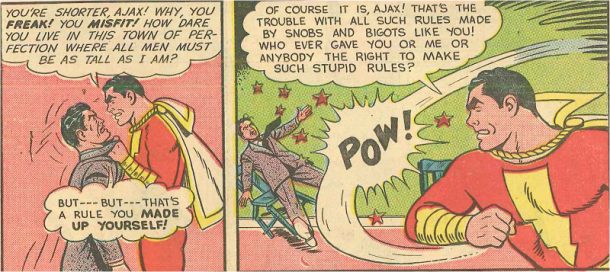
Having retrieved the keys from the neighbour, his front door closed and I ploughed my way back to the pickup. We trundled along the track I did not believe existed and reached the mountain of snow under which their homestead nestled. Smoke was coming out of a chimney. The neighbour had got the place ready for us.
We settled in. KK flitted in and out. She could have stepped out of a newspaper panel by Roy Crane – the originator of the adventure strip, and master of the sequential frame. He was an ex sailor who won as many art awards as he won medals in the navy. The obvious comparison in later years (Crane got underway in the 1920s) was Hugo Pratt’s incomparable Corto Maltese; also a graduate on the high seas. Pratt’s art and scripting – though not similar to Crane, towers over other European comics of the time. It’s shameful that Pratt is not better known over here, though over recent years his work has been increasingly translated into English. Singularly notable about Corto was how effectively and humanely he crossed lines of colour, nationality and gender.
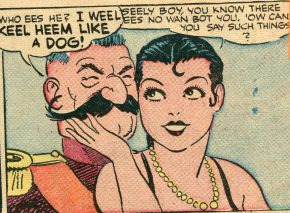
The boyfriend kept on drinking and talking. After KK put the kids down for the night, he told me he had he’d forced KK to write the romantic invitation that got me over, for which he apologized. I suggested KK choose between us. The boyfriend thought it a good idea. KK refused – it was nothing to do with her. I chose for her, and led her out of the kitchen. She didn’t resist, and he didn’t object.
In the next room I asked her to come and live with me in London. When we returned to the kitchen the boyfriend was gone. So was the loaded shotgun. We had to go. I grabbed the sleeping Arrow and my bag of comics. We packed quickly and wrapped Arrow up warmly. The moon was full and the snow made everything visible. We traipsed through the drifts.
The only refuge was the Black Panther. KK’s ex was hunting us. We’d be lucky to make it on foot. What if I had to run, and choose between carrying Arrow or the comics? The snow was tough going – I thought of Classics Illustrated again – a frame in Uncle Tom’s Cabin where Elisa was in flight with her son across the breaking ice, pursued by Slavers.
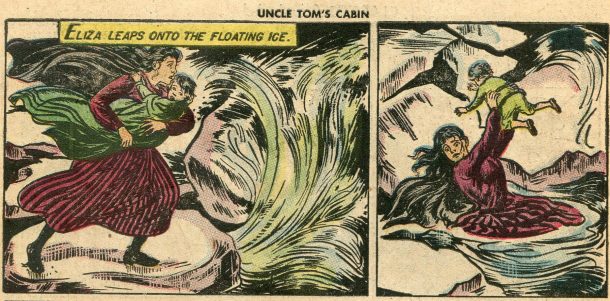
Reaching the neighbour’s house, I was nervous. I’d heard he knew I was from South Africa. KK reckoned he’d be OK and have no qualms about helping us – she was certain he’d see my true colours. The Panther found us and brought us to shelter.
He put on a record – ‘Grazing in the Grass’ by Hugh Masekela’. I told him that I met Hughie in South Africa when we were both fifteen. He was playing the trumpet Louis Armstrong gave him at a clandestine mixed jazz session. I told him about my flight from South Africa, and my interest in looking at race through comics.
Approaching the incorporation of any black characters in the American newspaper strips was a tough call. In the comics, it was often worse. Will Eisner, creator of The Spirit was a giant – one of the foremost artists of the Golden Age of comics. Breaking the white WASP cabal of the strips, he created a hefty black character in the 1940s, Ebony White. Ebony, who was The Spirit’s sidekick, was a terrible stereotype, offensively depicted, and in later life Eisner apologised for creating him. But compare Eisner’s portrayal with the dignity and presence of Uncle Tom in the contemporary Classics Illustrated, or indeed to anything by Jesse Marsh. Marsh was humanitarian, egalitarian and never stereotypically racist. His work stands in harsh contrast to other artists’ depiction in the Tarzan comics:
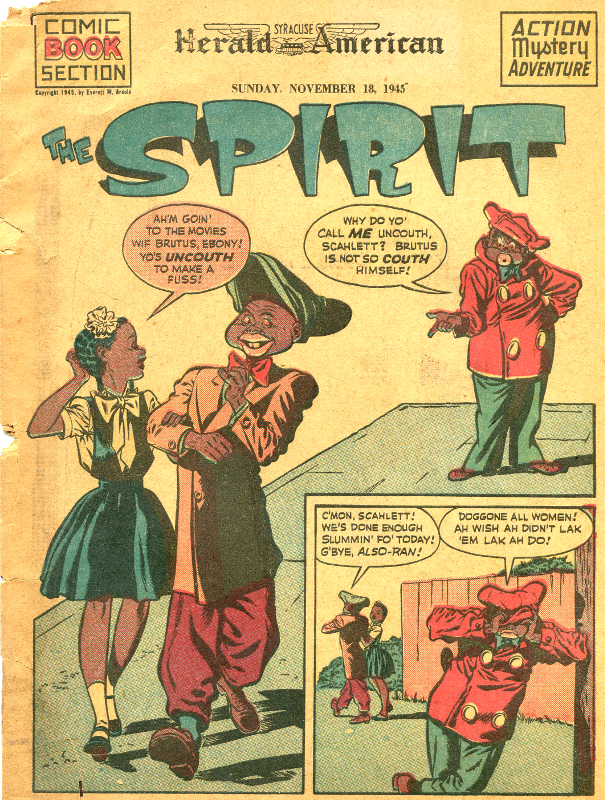
In contrast to Ebony White, the nobility of Classics Illustrated’s Uncle Tom does not diminish in any frame. Here, none of the characters were caricatures, not even Simon Legree.
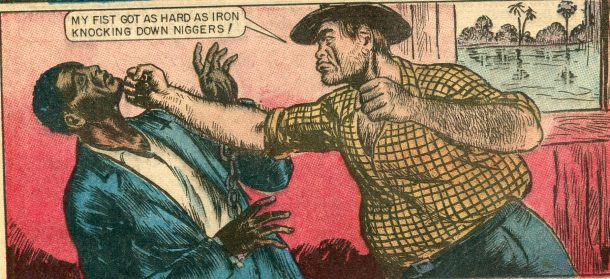
Hal Foster was the favoured artist in Tarzan. But in the next frame the rescued slaves are shown bowing to the superior white man in gratitude for saving them.
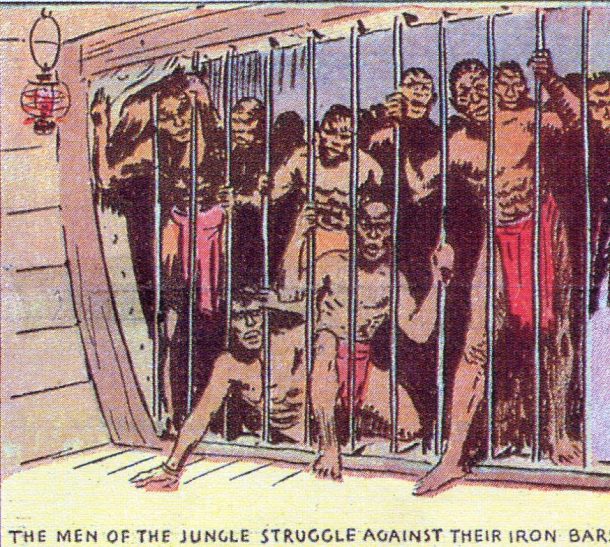
Back at the cabin, the Panther was out of cigarettes. The supermarket in Coeur d’Alene would still be open. I didn’t argue. Getting out of the car I dashed into the supermarket, bought the menthol cigs he wanted, and rushed out. I saw him drive away. The snowfall was thickening and the temperature was dropping. I turned back to the store. The lights were shutting down. I’d been locked out. I banged on the glass door. No one came.
I’d been reliably informed that at the present temperature no one could last more than four minutes in the outside. I banged louder.
There was no sign of life. I could just make out a glimmer in the far distance. It vanished, but it didn’t stop me waving my arms.
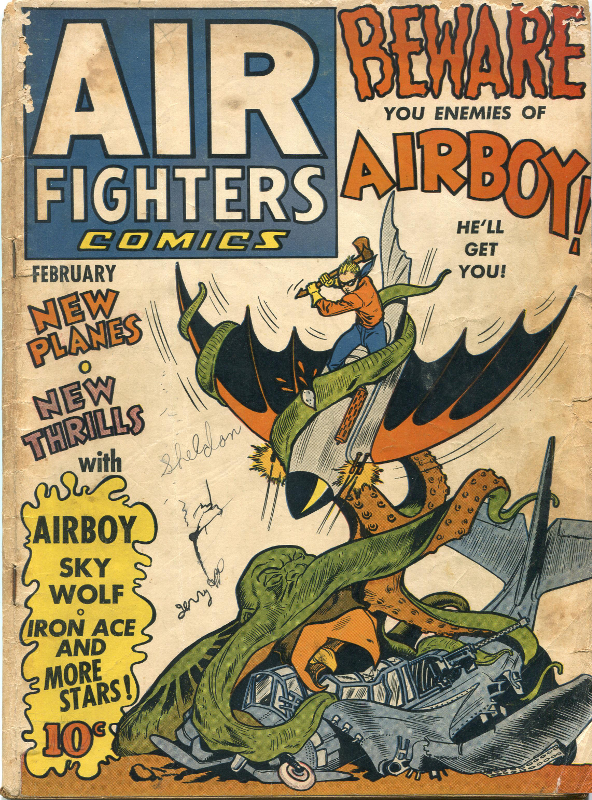
I suddenly thought of Airboy, a character introduced in Air Fighters Comics in the 40s, later renamed after its titular character. This comic book was a rare combination of excellence in both writer and artist, most notably between Fred Kida and Charles Biro. Artists changed over the years but Charles Biro wrote on. There was always strong moral content in his writing, and he was one of the most socially conscious writers of the Golden Age.
Looking up at the bright moon, I desperately hoped to see the silhouette of Birdie, the plane piloted by Airboy that flew on flapping wings, making its way towards me. Birdie could fly anywhere, and could land on a dime – the plane was forever responsive and sometimes decidedly sentient. With the wing-flapping Birdie, Airboy could fly out of any trap. I looked up again. There was nothing.
My four minute maximum exposure was up…
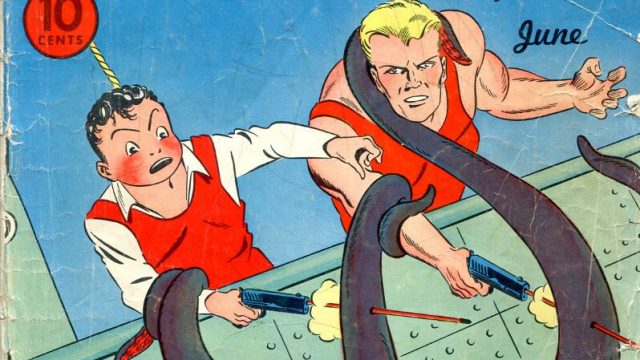
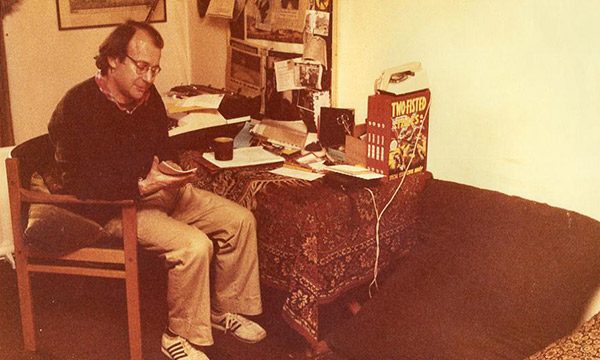
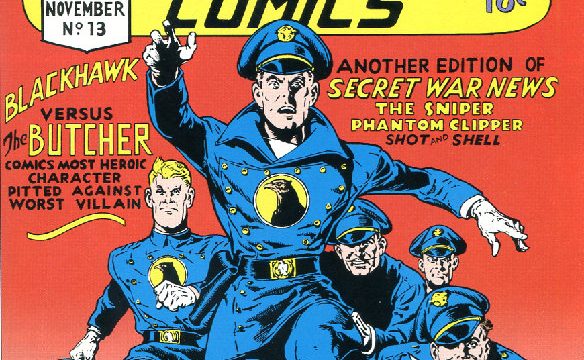
brilliant images and text….well done Ian
very funny, Ian. seamless transitions between text and images, comic text and literature and life and fiction.
Ian this is so good ! We also went to visit Karen in Idaho, once and have since been back thee at least three or four times. It is beautiful (in the summer – you should see Coeur d’Alene, and the Lakes in the north… I feel a bit responsible for your association with the V&A, you gave me Lindsay and I gave you van der Wateren. Alon and me both adored her, she was a wonderful lady.
Great story Ian! ….looking forward to the sequel………Happy Independence Day
Thanks for your engaging story and incorporation of beautiful comic artwork. How can you leave us hanging like that???
I look forward to the next instalment. I’d also like to see the return of your lunchtime presentations at the V&A.
Cheers, Bruce Marsh
I can’t imagine anyone else writing about comics with the same experience and knowledge that you have. Your life and work have come together wonderfully in this blog.
enthusiasm, commitment – love – makes the world go round. Thanks, Ian.
WHat a lyrical evocation of both comics annd your life with Karen and Arrow, Ian. A beautiffuly written recall of a lost time, and so on the button on race, comics and American history.
But as someone else said you leave us hanging!!
Another great blog by a great writer. More please!
Ian
My most sincere grovelling apologies. That’ll teach me to rad the first few sentences and check out before finishing the piece or indeed scrolling further down the page to see some of the fantastic imagery. As Mr Shindig says: More Please.
As always, Ian, a really interesting and insightful blog piece! Thankyou :)
Such a fascinating insight into the birth of this great collection. Keep em coming.
Loved this episode Ian. In times of crises, comic books come to the rescue eh? Great Imagery. Would like to see more of the Frederick Douglass issue. Studied his writing at uni. Be seeing you. x
And ‘Grazing in the Grass’ brings back memories of interviewing Hugh in the mid 80s. You evoke the times so well. Hated the illustrations for Ebony White. Be seeing you again, x
As it always goes with reading Ian, his story telling could be referred to as an iconic display of what “page turning”, or “kept me up all night” should mean when used to market a book. Of course this particular work isn’t long enough to keep one up all night, but we all want to read more. I say “as always” because when Ian would share a draft of what he was writing, something of a novel length like Ubuntu/Warriors of the Assegai, back in the early 70’s, the story telling really did keep me up all night. I was also reminded of his always challenging me to introduce him to one of my visiting American friends who might know as much about the history of the US a he did, learned from comic books. I know none of them, or me, would have known as much about black cowboys as he did, or does. I pray at least one of his longer literary works get published so we can all stay up all night.
Ian, I’ve read it at last – it was worth the wait! Being big on interest but small in comic knowledge I find the way you incorporate your life story with your ideas, beliefs and love of the comic medium truly inspiring. Your descriptions are so evocative and you always make me laugh – not least when you wondered what you’d do should you have to choose between Arrow and the comics!
Another great installment of Ian’s “life in comics”; can’t wait to see how the cliffhanger is resolved!
Can’t wait for next weeks thrilling installment.
Robert
Wow, Ian, what an adventure! This has it all, romance, a quest, dangers, a chase through the snow, substances, hard choices (the kid or the comic books) and a cliff hanger ending! Can’t wait for the next installment.
Hi Ian
Thanks for another great blog, with images, of your misadventures in the U.S.A. How dare you leave us on a cliffhanger for the next instalment! I can’t wait to read it when it appears. Keep fighting the good fight.
Leslie Glen